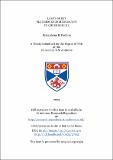Light-sheet fluorescence microscopy for biomedicine
View/
Date
12/06/2023Author
Supervisor
Grant ID
EP/R004854/1
EP/P030017/1
Keywords
Metadata
Show full item recordAbstract
The research motivation behind this thesis is to expand the information that can currently be extracted from an ex vivo biological sample via light-sheet fluorescence microscopy (LSFM) by enhancing the achievable resolution at an increased penetration depth. LSFM has already been used considerably for various biomedical research applications. During this thesis, I will explain why and in which contexts LSFM is a favoured technique compared to other currently available biomedical imaging tools. I will show how exotic beam shaping with Airy and Bessel-like beams can be implemented with LSFM to enhance the depth of quality, sub-cellular data available from complex biological samples (increasing the specificity and reach of the illumination to increase contrast in images). I will consider how the use of non-linear fluorescence excitation can improve upon the axial sectioning ability of LSFM with beam shaping in biological samples whilst exploiting the lowered attenuation of near infra-red illumination in biological tissues compared to visible illumination for linear fluorescence excitation. There are always fundamental limits to what we can achieve with optical microscopy. The guiding wish is to get a little bit closer to reaching these absolute physical limits with new, practical microscope designs aimed at medical microscopy applications.
Type
Thesis, PhD Doctor of Philosophy
Collections
Description of related resources
Light-sheet fluorescence microscopy for the biomedicine (thesis data) Poulton, P. B., University of St Andrews, 15 Jan 2024. DOI: https://doi.org/10.17630/db6a52a5-161d-4435-8ef2-f939111e5983Related resources
https://doi.org/10.17630/db6a52a5-161d-4435-8ef2-f939111e5983Items in the St Andrews Research Repository are protected by copyright, with all rights reserved, unless otherwise indicated.

